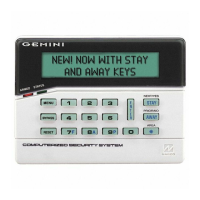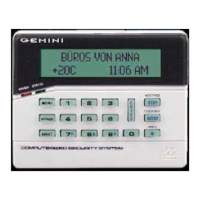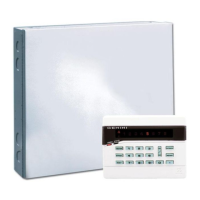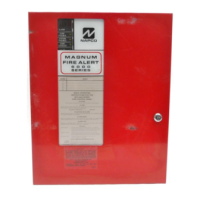Do you have a question about the NAPCO Gemini GEM-P3200 and is the answer not in the manual?
Details methods for downloading panel programs via computer.
Covers Easy Menu and Direct Address modes for keypad programming.
Programming for authorized users, limited to user codes and zone descriptions.
Essential preliminary information for entering dealer program mode.
Step-by-step instructions to enter dealer program mode.
Step-by-step instructions to enter Direct Address Program Mode.
Keypad commands for Direct Address Program Mode on K2AS/RP2ASe2.
Keypad commands for Direct Address Program Mode on K3DGTL/RP3DGTL/K4RF/K4 keypads.
Outlines the general procedure for programming system addresses and data.
Configuration of various system delays and timeouts.
Configuration of chime, AC fail report, and sensor watch delays.
Configuration for the panel access code used for door strike activation.
Setup for ambush codes to trigger silent central station reports.
Setting the dealer's code for accessing programming.
Selection of formats for central station receivers 1, 2, and 3.
Setting leading digits for pager reporting format.
Inputting telephone numbers for central station receivers.
Setting a security code for remote access during downloads.
Setting IDs for Telco 1 opening/closing events.
Setting IDs for Telco 2 opening/closing events.
Setting IDs for Telco 3 opening/closing events.
Codes used for reporting alarm and trouble conditions.
Configuration for system-wide reporting options.
User reporting code settings for Telco 1.
User reporting code settings for Telco 3.
How the system responds to global events and troubles.
System events and troubles reporting for Area 1.
System events and troubles reporting for Area 2.
Detailed zone options and their address locations.
Default zone option settings after exiting Easy Menu Mode.
Configuration of system options like fire reset and day zone watch.
Option to disable fire alarm reset functionality.
Enables day zone watch feature for enhanced monitoring.
Configuration for options like Telco Fail, Veri-phone zones, and Auxout Chirp.
Configuration for ACM access, TCP/IP, and keypad blanking.
Assigns keypad type and area for connected keypads.
Selects functions like tour station, access, and keypad alarm behavior.
Assigns zone numbers for ACM door contact and entry control.
Global settings for ACM features like two-swipe arming and logging.
Defines arm/disarm area settings and stealth mode for ACM doors.
Schedules free access times for specific relays or doors.
Hexadecimal assignment for keypad and ACM door #1 home areas.
Configures emergency free access zone numbers.
Configures user access levels and area permissions.
Configures EZM groups for zones and their areas.
Controls EZM PGM terminal activation based on armed areas.
Configures priority arming settings for specified areas.
Enables logging of all keypad access events.
Settings for disarming area outputs for burglary, fire, and relays.
Programming the number and types of RF receivers used.
Setting supervision timers for different RF transmitter types.
Detailed setup for controlling up to 24 external relays.
Covers relay options, area, timeouts, event IDs, and conditions.
Configuration for the number of connected relay board modules.
Resets the dealer program to default settings.
Resets the entire system program to factory defaults.
General information about using the User Program Mode.
Step-by-step guide to enter User Program Mode.
Instructions for programming user codes on GEM-K2AS keypad.
Instructions for programming user codes on GEM-K3DGTL keypad.
Instructions for programming user codes on GEM-K4RF keypad.
Instructions for setting up keypad options and addresses.
How to assign unique addresses to keypads.
How to disable the keypad sounder.
Steps for safely powering up the control panel.
Details methods for downloading panel programs via computer.
Covers Easy Menu and Direct Address modes for keypad programming.
Programming for authorized users, limited to user codes and zone descriptions.
Essential preliminary information for entering dealer program mode.
Step-by-step instructions to enter dealer program mode.
Step-by-step instructions to enter Direct Address Program Mode.
Keypad commands for Direct Address Program Mode on K2AS/RP2ASe2.
Keypad commands for Direct Address Program Mode on K3DGTL/RP3DGTL/K4RF/K4 keypads.
Outlines the general procedure for programming system addresses and data.
Configuration of various system delays and timeouts.
Configuration of chime, AC fail report, and sensor watch delays.
Configuration for the panel access code used for door strike activation.
Setup for ambush codes to trigger silent central station reports.
Setting the dealer's code for accessing programming.
Selection of formats for central station receivers 1, 2, and 3.
Setting leading digits for pager reporting format.
Inputting telephone numbers for central station receivers.
Setting a security code for remote access during downloads.
Setting IDs for Telco 1 opening/closing events.
Setting IDs for Telco 2 opening/closing events.
Setting IDs for Telco 3 opening/closing events.
Codes used for reporting alarm and trouble conditions.
Configuration for system-wide reporting options.
User reporting code settings for Telco 1.
User reporting code settings for Telco 3.
How the system responds to global events and troubles.
System events and troubles reporting for Area 1.
System events and troubles reporting for Area 2.
Detailed zone options and their address locations.
Default zone option settings after exiting Easy Menu Mode.
Configuration of system options like fire reset and day zone watch.
Option to disable fire alarm reset functionality.
Enables day zone watch feature for enhanced monitoring.
Configuration for options like Telco Fail, Veri-phone zones, and Auxout Chirp.
Configuration for ACM access, TCP/IP, and keypad blanking.
Assigns keypad type and area for connected keypads.
Selects functions like tour station, access, and keypad alarm behavior.
Assigns zone numbers for ACM door contact and entry control.
Global settings for ACM features like two-swipe arming and logging.
Defines arm/disarm area settings and stealth mode for ACM doors.
Schedules free access times for specific relays or doors.
Hexadecimal assignment for keypad and ACM door #1 home areas.
Configures emergency free access zone numbers.
Configures user access levels and area permissions.
Configures EZM groups for zones and their areas.
Controls EZM PGM terminal activation based on armed areas.
Configures priority arming settings for specified areas.
Enables logging of all keypad access events.
Settings for disarming area outputs for burglary, fire, and relays.
Programming the number and types of RF receivers used.
Setting supervision timers for different RF transmitter types.
Detailed setup for controlling up to 24 external relays.
Covers relay options, area, timeouts, event IDs, and conditions.
Configuration for the number of connected relay board modules.
Resets the dealer program to default settings.
Resets the entire system program to factory defaults.
General information about using the User Program Mode.
Step-by-step guide to enter User Program Mode.
Instructions for programming user codes on GEM-K2AS keypad.
Instructions for programming user codes on GEM-K3DGTL keypad.
Instructions for programming user codes on GEM-K4RF keypad.
Instructions for setting up keypad options and addresses.
How to assign unique addresses to keypads.
How to disable the keypad sounder.
Steps for safely powering up the control panel.
| Type | Control Panel |
|---|---|
| Zones | 32 |
| Keypads Supported | Up to 8 |
| Partitions | 2 |
| Wireless Receiver | Built-in |
| Battery Backup | 12VDC 7Ah |
| Compatible Transmitters | NAPCO |
| Dimensions | 12.5" |
| Power Supply | 16.5VAC transformer |












